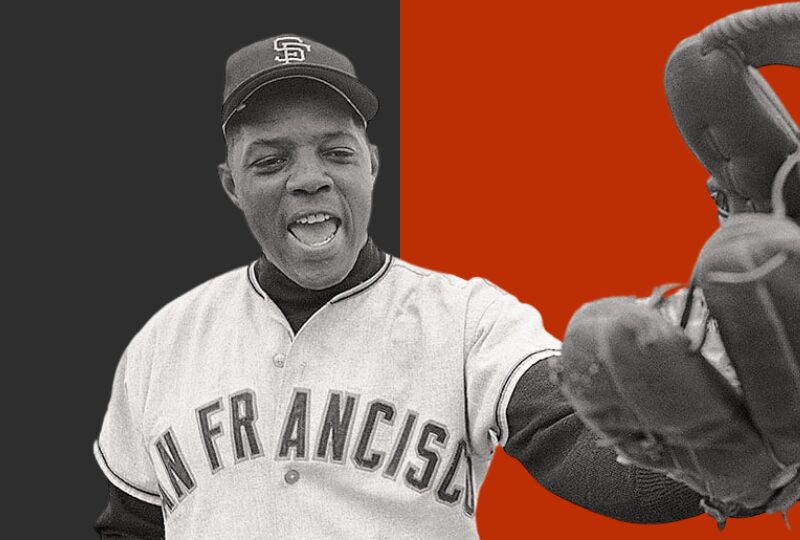In 2021, seventy years after he made his debut with the New York Giants, Willie Mays received a Lifetime Achievement Award from the editors of Baseball Digest.
If anyone achieved during their lifetime, it was The Say Hey Kid. In a 23-year playing career that spanned four decades, Mays established a record that represents the breadth of his physical abilities on a baseball diamond.
Mays won a batting title. He led his league in home runs and stolen bases four times each. The first (and still only) many to do that. He hit 50+ homers twice, in an era when a good power hitter was satisfied with 20 four-baggers. Mays had 100+ RBI ten times, and he even led his league in triples three times.
Awards were no stranger to Willie: he won the Gold Glove for his outfield play in the first 12 seasons that award was handed out. He was an All-Star a record 24 times, and an MVP twice. He probably should have won the MVP eight or ten times. He was the best all-around player of his generation, and it wasn’t all that close.
The lifetime award from Baseball Digest was the first time that magazine had given such an honor, and it was appropriate that they presented it to Willie. In 1954, he became the first black person to appear on the cover of the magazine. It marked the end of a curious drought. One that brings into question the racial awareness of the editors of the magazine at that time.
Jackie Robinson never appeared on the cover of Baseball Digest. In 1947, Robinson broke the color barrier in the white major leagues. He finished fifth in MVP voting and was named Rookie of the Year. In 1949, Robinson was named MVP of the National League, and led the Brooklyn Dodgers to the World Series. In the next five seasons, Jackie and the Dodgers appeared in three more World Series. But the folks at Baseball Digest didn’t once choose to place Robinson on the cover.
Mays appeared on the cover of Baseball Digest four times. Three times solo, and once in a montage of other players. His brilliant smile is evident in most of his appearances. Few athletes seemed to enjoy playing their game more than Willie did. He ran like a kid, he jumped like he was filled with joy. He played stickball in the New York city streets with his young fans.
It’s not important now whether Baseball Digest made a conscious decision to shun black players from the front of their publication. It’s almost certain that there was a prejudice. Consider this: the November 1947 issue, which dealt with the just-completed World Series between the Dodgers and New York Yankees, had a lead story about Dixie Walker of Brooklyn. Walker was reportedly the player most vocal in his opposition to having a black teammate that season. The article doesn’t mention Robinson’s name at all. In fact, not once in any of the 1947 issues was Jackie’s name mentioned. In February 1948, the magazine led with a long article about Brooklyn president Branch Rickey and his manager, Leo Durocher. Rickey was the man who signed Robinson and showed the moral courage to confront MLB’s unwritten ban against black players. But the article, which ran more than 1,500 words, never mentioned that issue, nor did it mention Robinson.
The editors of Baseball Digest in the late 1940s and early 1950s, chose to ignore black players and the issue of integration. They didn’t want to upset their economic viability. They were afraid to lose even one subscriber over black baseball players. That’s why it took until 1954 to put Mays on the cover. That’s why Robinson never appeared on the front cover, even in the 1960s when he was elected to the Hall of Fame, and became a civil rights icon.
Bill Francis wrote a superb article for the Baseball Hall of Fame website in 2022, celebrating the 80th anniversary of Baseball Digest. Understandably, Francis does not address the “elephant in the room” subject of race and the pages of that magazine. It really isn’t the forum, nor was Francis obligated to make the point. But, the fact that Baseball Digest was so silent on integration in its sport, and chose to wait seven years after Jackie Robinson broke the color barrier to put a black man on its cover, is illustrative of the institutional racism of that era.
The editors of that magazine may not have been racists, and I’m not saying they were as individuals. But the decision by the managing editor, a man named Herbert F. Simons, (formerly a Chicago newspaper man), were made with prejudice. It wasn’t until the 1960s that the publication began to praise Robinson for his role in changing the game.
Willie Mays died last week at the age of 93. He was baseball’s greatest center fielder, and arguably the best player in the history of the sport. He began his professional major league career in the negro leagues. He was one of the last men alive to have played in the negro leagues in the 1940s. His passing reminds us of the important role he and other pioneers played in integrating baseball.
RELATED
Giants All-Time Team >
100 Greatest Center Fielders of All-Time >
Mays and the 1973 World Series >
20 Greatest Giants of All-Time >







